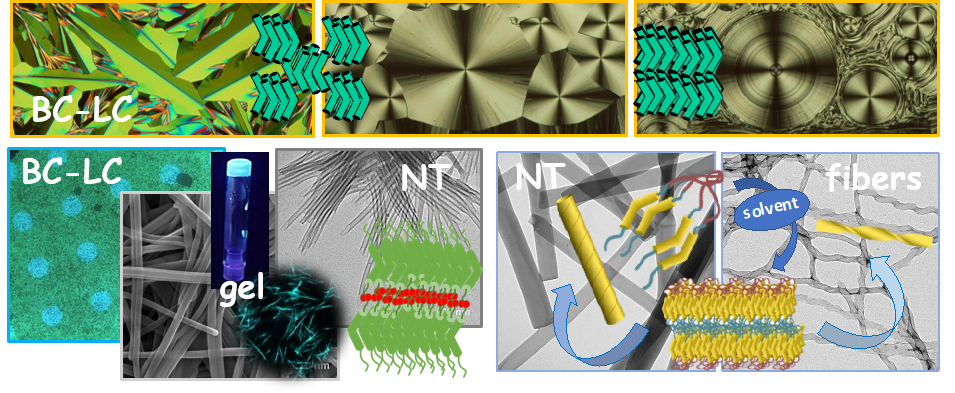Functional supramolecular materials from bent-core building-blocks
 Beyond their use in displays, Liquid Crystals are a great tool to achieve new advanced materials that respond to current technological challenges. In this objective, a "nanoarchitectural" approach recognizes molecular design as key, both at the level of supramolecular assembly and functionality. Bent-core liquid crystals are recognized by us as a highly innovative tactic with great potential for developing functional nanostructured materials with controlled 2D and 3D polar and/or chiral organizations. But in addition to this challenge, we also extend our goals to use the bent-core molecules as building-blocks towards other supramolecular systems, due to the persistence of similar intermolecular interactions in the presence of liquids and on surfaces. Therefore, based on the self-assembling versatility of bent-core molecules, our research is committed to the development of nanostructured supramolecular soft-systems, such as aggregates with controlled morphologies, physical gels, including ionogels, and lyotropic liquid crystals, hardly unprecedented in the development of new functional materials based on bent-core units. In response to the social demand for advanced materials, our research pursues control in the design, synthesis, processing and properties of these materials as candidates for innovation in CP light emitters, flexible electrolytes or energy conversion and storage, with results that should allow both, their application as to advance beyond the "frontier" of knowledge.
Beyond their use in displays, Liquid Crystals are a great tool to achieve new advanced materials that respond to current technological challenges. In this objective, a "nanoarchitectural" approach recognizes molecular design as key, both at the level of supramolecular assembly and functionality. Bent-core liquid crystals are recognized by us as a highly innovative tactic with great potential for developing functional nanostructured materials with controlled 2D and 3D polar and/or chiral organizations. But in addition to this challenge, we also extend our goals to use the bent-core molecules as building-blocks towards other supramolecular systems, due to the persistence of similar intermolecular interactions in the presence of liquids and on surfaces. Therefore, based on the self-assembling versatility of bent-core molecules, our research is committed to the development of nanostructured supramolecular soft-systems, such as aggregates with controlled morphologies, physical gels, including ionogels, and lyotropic liquid crystals, hardly unprecedented in the development of new functional materials based on bent-core units. In response to the social demand for advanced materials, our research pursues control in the design, synthesis, processing and properties of these materials as candidates for innovation in CP light emitters, flexible electrolytes or energy conversion and storage, with results that should allow both, their application as to advance beyond the "frontier" of knowledge.
Involved researchers: M Blanca Ros (This email address is being protected from spambots. You need JavaScript enabled to view it.
), Raquel Giménez, José Luis Serrano, Joaquín Barberá.
PhD: Carlota Auria, Ivan Marín.
TFG & TFM: Alfonso Navarro.
Key recent publications:
J. Mater. Chem. C, 2022, 10, 18200. https://doi.org/10.1039/d2tc04106e
J. Mater. Chem. C, 2022, 10, 12012. https://doi.org/10.1039/D2TC02546A
Nanoscale Adv., 2021, 3, 1682. https://doi.org/10.1039/D0NA00744G
J. Mater. Chem. C, 2020, 8, 1998. https://doi.org/10.1039/C9TC06002B
J. Mater. Chem. C, 2019, 7, 14454. https://doi.org/10.1039/C9TC04179F
Adv. Mater. 2016, 28, 6586 . https://doi.org/10.1002/adma.201600311